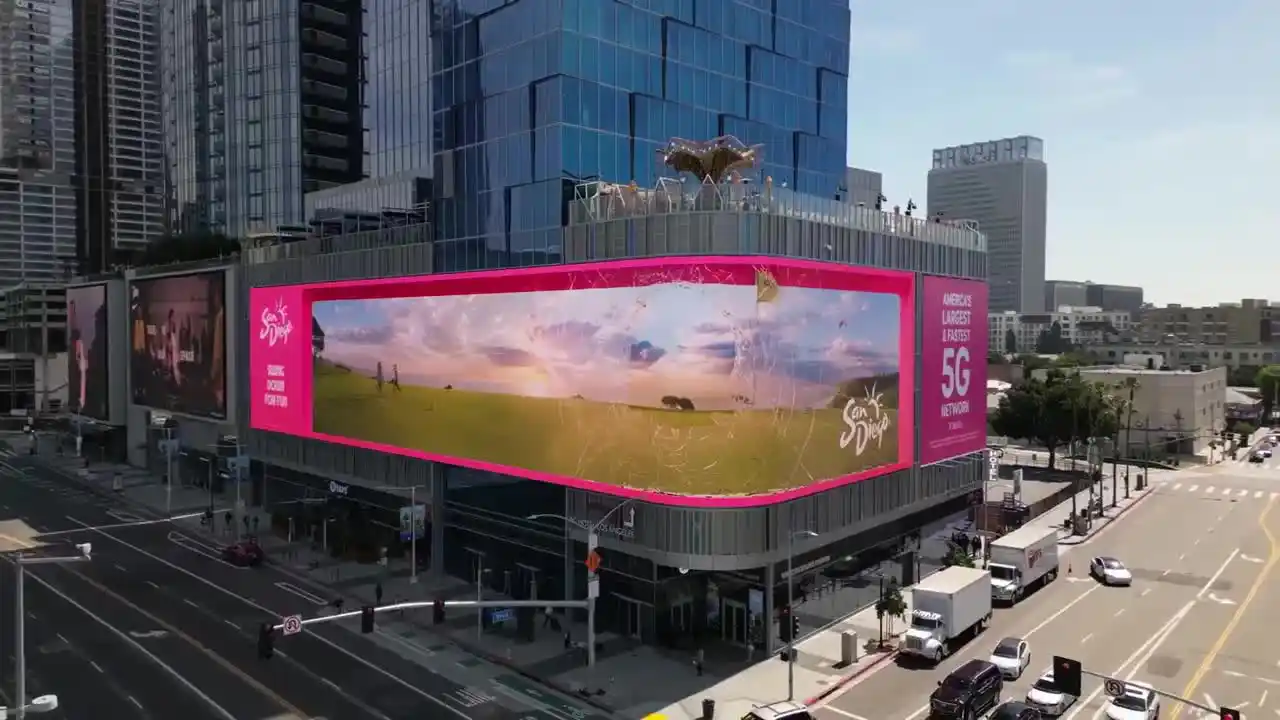
Outdoor LED displays have become a cornerstone of modern digital signage, offering unmatched visibility, flexibility, and impact. However, the success of your message isn't just about hardware quality or screen size — it's about how well your content is optimized for the unique challenges of outdoor environments.
Haala ifa garmalee irraa kaasee hanga fageenya ilaalchaa adda addaa fi akkaataa tiraafikaa daayinamikii, qabiyyee mul’ataa agarsiisa LED alaatif fooyyessuun dizaayinii kalaqaa, sirritti teeknikaa fi hubannoo naannoo walitti makamuu barbaada. Barreeffama kana keessatti dhiheessinatooftaalee ogeeyyii torbakanneen aesthetics bira darbanii, irratti xiyyeeffatanmuuxannoowwan teeknikaa gaarii ta’anqabiyyeen kee akka geessu mirkaneessuufmul’achuu, hirmaannaa, fi ROI ol’aanaa.
Naannoo ala saffisaan socho'u keessatti, daawwattoonni yeroo baayyee ergaa kee adeemsisuuf sekondii muraasa qofa qabu. Kun salphaa ta'uun filannoo dizaayinii qofa akka hin taane taasisa — barbaachisummaa dha.
Ergaa jalqabaa keessa kaa'ijechoota 5–7
Fayyadamuuqubee jajjaboo sans-serif(fkn, Arial Bold, Helvetica Black) dubbifamuu guddisuuf
Yoo xiqqaate kunuunsaa40% iddoo negaatiiviiwalxaxiinsa ijaa hir’isuuf
Xiyyeeffannoo aergaa hundee tokko furmaata tokkoof
Haalli xiqqaan kun sochii fi yeroo keessattillee dubbifamuu olaanaa mirkaneessa — keessumaa biilboordii daandii guddaa fi agarsiisa geejjibaa magaalaaf murteessaadha.
Faallaan halluu haalawwan ibsaa adda addaa keessatti mul’achuu mirkaneessuu keessatti wantoota murteessoo ta’an keessaa isa tokkodha.
| Seenaa | Halluuwwan Gorfaman | Mul'achuu Boost |
|---|---|---|
| Ifa guyyaa | Adii Gurraacha irratti | +83% |
| Aduu Walakkeessa | Keelloo irratti Biluu | +76% |
| Halkan yeroo | Cyan Gurraacha irratti | +68% |
Walnyaatinsa halluu kan gadi ta'e fayyadamuu irraa fagaadhuGaraagarummaa ifaa %50, keessumaa sa’aatii ifa guyyaa ifa aduu mul’ata walfaallaa xiqqaa qabu dhiquu danda’utti.
Hariiroo fageenya ilaalchaa fi haala qabiyyee gidduu jiru hubachuun bu’a qabeessummaa teeknikaatiif barbaachisaa dha.
Olka'iinsa Qubee Xiqqaa (inchii) .= Fageenya Ilaaluu (miila) / 50
Guddina Fakkii Gaarii (inchiitiin) .= (Fageenya Ilaaluu × 0.6) / PPI Iskiriinii
Fakkeenyaaf, agarsiisa irraa mul'atu500 feet fagaatee argamafayyadamuu qaba:
Olka'iinsa qubee xiqqaa:Inchii 10 ta'a
Giraafiksii ijoo dhuunfachuu60% naannoo iskiriinii
Foormulaawwan kunniin, taayipogiraafii fi fakkiiwwan osoo hin jallisin ykn piikseeleeshiniin ifatti dubbifamuu akka danda’an mirkaneessu.
Animeeshiniin xiyyeeffannoo hanga40%, hojiirra oolmaan sirrii hin taane daawwataan dadhabbiin ykn yaada isaa akka jeequ gochuu danda’a.
Turtii sochii qaamaa elementii tokkoof:Sekondii 3–5
Saffisa ce’umsaa: 1.1.Sekondii 0.75–1.25 ta’a
Irradeddeebii:Sekondii 7–10 keessatti elementii socho’aa 1
Fayyadamuusochii kallattii(fkn, bitaa gara mirgaatti, gubbaa-gadi) xiyyeeffannoo gara qaamolee ijoo akka buttooni waamicha gocha (CTA) ykn asxaa maqaa qajeelchuuf.
Fooyya’iinsi qabiyyee walfakkaataan agarsiisa kee yeroon barbaachisaa fi bobba’aa ta’ee akka hojjetu taasisa.
Ergaawwan ga’umsa olaanaa qaban: Hundaa naannessiguyyoota 12–15
Duula beeksisa: Update everysa’aatii 36–72
Daataa yeroo qabatamaa (haala qilleensaa, yeroo, taateewwan) .: Sa’aatii tokkotti ykn yeroo baay’ee haaromsuu
Hojiitti hiikuuQormaata A/Bgaraagarummaa qabiyyee dachaa ta’een maaltu dhaggeeffattoota kee biratti akka gaariitti akka dhaga’amu adda baasuuf.
Agarsiistonni LED alaa haala qilleensaa fi sadarkaa ifaa jijjiiramaa wajjin waldhabuu qabu. Qabiyyeen kee haaluma kanaan madaquu qaba.
Haala Ifa Guyyaa:Faallaa (contrast) dabaluudhaan30%
Haala Roobaa:Qubeewwan furdisuu by15%dubbifamuu fooyya’aa ta’eef
Hojii Halkan:Ifa hir'isuu garaSadarkaa guyyaa keessaa %65glare fi qisaasama anniisaa irraa of eeguuf
Sirnoonni sadarkaa olaanaa qaban walitti makamuu danda’usensaroota yeroo dhugaafiLoojikii CMShaalawwan naannoo irratti hundaa'uun ofumaan qajoojiiwwan qabiyyee sirreessuuf.
Naannoleen hedduun yaada isaanii akka hin jeeqneef ykn balaa akka hin uumamneef ifa, lilmoo fi frequency flash irratti daangaa seeraa kaa’u.
Yoo xiqqaate kunuunsaaQabiyyee 50% kan hin jijjiiramnetartiiba sochii qaamaatiin
Ifa olka'aa kophee at5000 nits ta'a
Ergaawwan naanneffaman gidduutti addaan fageenya dirqamaa dabali
Saffisa balaqqeessaa (flashing rates) gara armaan gadiitti daangessi3 Hz ta’a
Qajeelfama kana hordofuudhaan dambiiwwan naannoo keessanii eeguu qofa osoo hin taane ergaa bu’a qabeessa ta’e eeguudhaan nageenya hawaasaa ni eegdu.
Gahumsa sirna kee ol kaasuuf, kanneen hojiirra oolchuu yaadaafooyya’iinsa sadarkaa ogummaatti:
Hordoffii raawwii qabiyyeetiif walitti makamuu xiinxala yeroo dhugaa
Qabiyyee ofumaan madaqsuu fayyadamuunAPIwwan haala qilleensaa
Iskeelii furmaata daayinamikii karaasensaroota ifa naannoo
Sagantaa tilmaama humna kan qabudaataa akkaataa tiraafikaa
Walnyaatinsi kun agarsiisa LED kee gara waltajjii qunnamtii sammuu qabuutti jijjiiru, yeroo qabatamaa keessatti naannoo isaa fi amala dhaggeeffattootaa wajjin walsimsiisuu danda'a.
Suphaan yeroo yeroon qulqullina suuraa walfakkaatu mirkaneessaa fi umurii haardwaara LED keessanii dheeressa.
Torban lamatti al tokko:Pixel fayyaa adda baasuu
Ji'a ji'aan:Qormaata safartuu halluu
Kurmaana kurmaanaan:Sakatta'iinsa walfakkaatummaa ifaa
Waggaa waggaan:Odiitii sirna guutuu fi gamaaggama qabiyyee fooyyessuu
Suphaan sirrii ta’e baasii yeroo dheeraa hir’isuu fi ifa agarsiisaa kan eegu yoo ta’u, kunis bu’a qabeessummaa qabiyyee irratti kallattiin dhiibbaa qaba.
Qabiyyee agarsiisa LED alaatif fooyyessuunis waa'ee kalaqa qofa miti — tattaaffii ogummaa hedduu walitti makamuudhadizaayinii mul’ataa, injinariingii naannoo, fi murtee daataatiin geggeeffamu. Tooftaalee mirkanaa'an torban kana hordofuudhaan, qabiyyeen kee haala kamiyyuu keessatti ifa, dirqisiisaa fi kan walsimu ta'ee akka turu ni mirkaneessita.
Taappeellaa tokko yookiin guutummaa neetworkii agarsiisa alaa bulchaa jirtanis, hubannoowwan teeknikaa kana walitti makuun ergaa qabachuu, dhaggeeffattoota hirmaachuu fi bu'aa invastimantii kee haalaan ni fooyyessa.
Yaada Ho'aa
Oomishaalee Ho'aa
Get a Free Quote Instantly!
Talk to Our Sales Team Now.
Yoo oomisha keenyaaf fedhii qabaattan hatattamaan nu qunnamaa
Furmaata fedhii daldalaa keessanii haala gaariin guutu qorachuu fi gaaffii qabdan kamiyyuu deebisuuf garee gurgurtaa keenya qunnamaa.
Teessoo Imeelii:info@reissopto.com irraa argattuTeessoo Warshaa:Gamoo 6, Paarkii Industirii Agarsiisa Paanaalii Diriiraa Huike, Lakk.1, Daandii Gongye 2ffaa, Hawaasa Shiyan Shilong, Aanaa Bao'an, magaalaa Shenzhen , Chaayinaa
whatsapp:+8615217757270